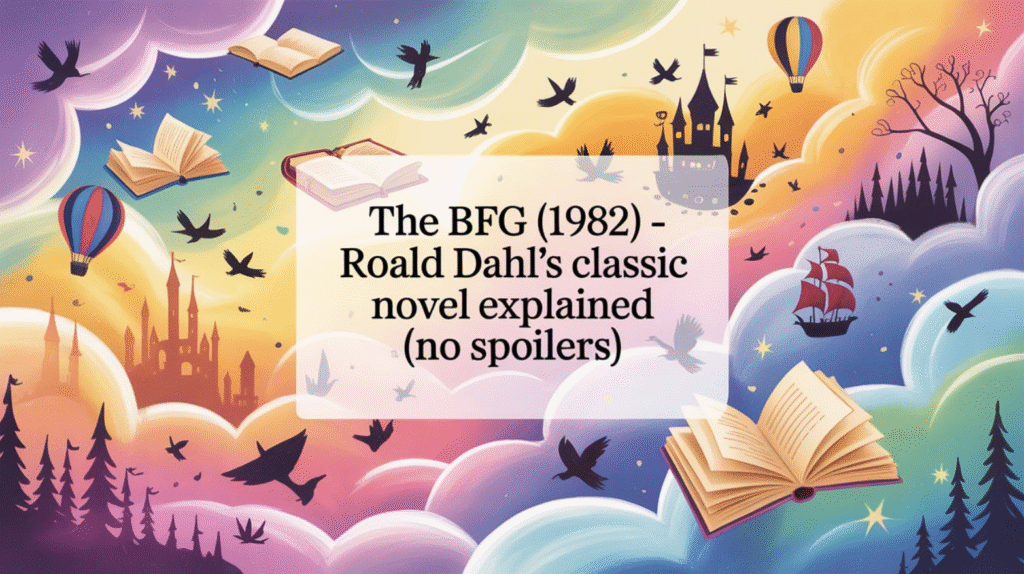Affiliate Disclosure & Image Credits
As an Amazon Associate, I earn from qualifying purchases. This article may contain affiliate links. If you click one of these links, I may earn a small commission at no additional cost to you.
Book cover images in this article are provided courtesy of Open Library.
The BFG by Roald Dahl was published in 1982 and has remained one of the most beloved children’s fantasy novels of all time.
It tells the story of a young orphan named Sophie who befriends a gentle giant, the Big Friendly Giant, and together they set out to stop man-eating giants from terrorising the world’s children.
Blending imagination, wit and warm heart, the novel captures the spirit of courage and the power of dreams that define Dahl’s best works.

The Setting & Author Context
Roald Dahl sets The BFG across two contrasting worlds: a lonely London orphanage and the wild, vast Giant Country.
This shift from ordinary to fantastical mirrors the transition many of his young heroes undergo, escaping cruel circumstances to discover kindness and wonder elsewhere.
Dahl wrote the story in memory of his daughter Olivia, who passed away from measles in the 1960s, and the book became an act of love towards children everywhere.
His signature “Gobblefunk” language, a mix of invented words and misheard phrases, is central to the book’s magic. The BFG’s silly yet sincere speech turns nonsense into wisdom, reminding readers that kindness can be found in the most unexpected forms.
Plot Summary (No Spoilers)
When Sophie is snatched from her bed in the dead of night by a mysterious giant, she expects the worst.
Instead, she meets the BFG — a dream-catching gentle giant who refuses to eat humans and spends his nights gathering good dreams for children.
In Giant Country, Sophie learns that nine other giants are not so benevolent. They devour children across the world each night, and the BFG has long been powerless to stop them.
Together, Sophie and the BFG devise a plan so outrageous it involves the Queen of England, a dream of giants, and the biggest breakfast in Buckingham Palace history.
The story blends adventure with comedy and carries an undercurrent of empathy and imagination that has made it timeless.
Characters & Themes
Main Characters
- Sophie (MC): Curious, intelligent, and courageous; her childlike sense of right and wrong drives the plot.
- The BFG: Kind-hearted yet lonely, his mangled language and dream-collecting make him Dahl’s most endearing creation.
- Supporting Cast: The nine evil giants (Fleshlumpeater, Bloodbottler, Bonecruncher and others), the Queen of England, and palace guards who add humour and scale.
Core Themes
- Friendship across difference: A child and a giant forge trust through shared kindness.
- Courage vs fear: Small heroes face impossible odds and change their world.
- Imagination & language: Word-play as liberation — Dahl turns nonsense into truth.
- Dreams & innocence: The BFG’s dreams are a symbol of hope and compassion.
Tropes & Reader Experience
Key Tropes
- Orphan-hero journey
- Friendly monster archetype
- Hidden magical world within the ordinary
- “Good vs evil” moral clarity
- Dream symbolism & word alchemy
Tone, Pacing & Style
The tone balances gentle humour with occasional dark edges — typical of Dahl. Scenes move quickly; dialogue is rhythmic and full of invented terms that invite aloud reading.
While marketed for children 8+, its linguistic creativity and emotional depth make it endlessly re-readable for adults.
Who It’s Best Suited For
- Middle-grade readers who enjoy fantasy with humour and heart.
- Families seeking a bedtime classic that ages well.
- Fans of other Roald Dahl titles (Matilda, The Witches, Charlie and the Chocolate Factory).
- Readers interested in moral fantasy with kindness as its core strength.
Reader Suitability / Why Read It
Choose The BFG if you’re looking for a story that celebrates imagination and friendship without preaching.
It’s a book that invites readers to listen for the “music of dreams” — to believe that gentle courage and laughter can change the world.
Educators use it for language lessons on creative word formation; parents treasure it for its balance of humour and emotional warmth.
Even four decades later, its themes of empathy and wonder resonate strongly in an age of noise and speed.
Continue Reading Roald Dahl’s World
If you enjoy The BFG, you’ll likely love Dahl’s other fantastical novels in publication order:
- James and the Giant Peach (1961)
- Charlie and the Chocolate Factory (1964)
- Fantastic Mr Fox (1970)
- Danny the Champion of the World (1975)
- The BFG (1982)
- Matilda (1988)
- The Minpins (1991)
Each book shows Dahl’s growth from darkly comic storyteller to master of imaginative hope.
